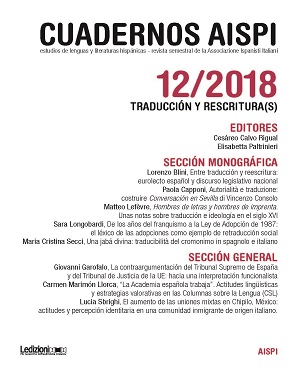Authorship and Translation: Building Conversación en Sevilla by Vincenzo Consolo
DOI:
https://doi.org/10.14672/0.2018.1489Abstract
Starting from the study of the oral sources used in Conversación en Sevilla, and their transcriptions and translation, an analysis of the macro and micro-textual levels is proposed. This analysis focuses on the procedures employed to transfer the text from orality to writing and to translate it. At the same time special attention is paid to how the text is assembled, by looking at the transfer of ‘pieces’ of discourse from one section to another.
Downloads
References
AA.VV., (2005) “Leggere Vincenzo Consolo”, Quaderns d’Italiá, 10.
Bassnett, Susan; Bush, Peter (2006), The Translator as Writer, Londra, New York, Continuum international.
Benedetti, Carla (1999), L’ombra lunga dell’autore. Indagine su una figura cancellata, Milano, Feltrinelli.
Bovie, Smith Palmer (1961), “Translation as a Form of Criticism”, The Craft and Context of Translation: a symposium, eds. William Arrowsmith, Roger Shattuck, Austin, University of Texas.
Buffagni, Claudia; Garzelli, Beatrice; Zanotti, Serenella, eds. (2011), The Translator as Author: Perspectives on Literary Translation, Università per Stranieri di Siena, 28-29 maggio 2009, Münster, Lit Verlag.
Carmignani, Ilide (2014), Gli autori invisibili, Lecce, Besa Editrice.
Chamberlain, Lori (1988/200), “Gender and the Metaphorics of Translation”, ed. Lawrence Venuti, The Translation Studies Reader, London-New York, Routledge: 314-329.
Consolo, Vincenzo (2014), Conversación en Sevilla, edizione del testo, traduzione, introduzione e note a cura di M.A. Cuevas, Sevilla, La Carboneria.
—, (2007), A este lado del Faro, introduzione, traduzione e note a cura di M.A. Cuevas, Parténope, Valencia.
—, (2013), La herida de abril, edizione del testo, traduzione, introduzione e note a cura di M.A. Cuevas, Traspiés, Granada.
—, (2016a), Conversazione a Siviglia, edizione del testo, traduzione, introduzione e note a cura di M.A. Cuevas, Caltagirone, Lettere daQalat.
—, (2016b), Sicilia paseada traduzione, introduzione e note a cura di M.A. Cuevas, Traspiés, Granada.
—, L’ora sospesa (2018), edizione del testo, introduzione e note a cura di M.A. Cuevas, Le farfalle, Valverde di Catania.
Cuevas, Miguel Ángel (2000), “La constante metaficcional en la obra de Vincenzo Consolo”, Una veritade ascosa sotto bella menzogna. Zur italianischen Erzählliteratur der Gegenwart, eds. Hans Felten, David Nelting, Frankfurt am Main, Peter Lang: 129-135.
—, (2005), “Ut pictura: el imaginario iconográfico en la obra de Vincenzo Consolo”, Quaderns d’Italià, 10: 63-77.
—, (2006a), “Le tre edizioni de La ferita dell’aprile: le varianti”, La parola scritta e pronunciata. Nuovi saggi sulla narrativa di Vincenzo Consolo, ed. Giuliana Adamo, Lecce, Manni: 49-69.
—, (2006b), “Lunaria antes de Lunaria”, «Lunaria» vent’anni dopo, ed. Irene Romera, Valencia, Universidad: 153-169.
—, (2010), “Ancora su Antonello”, Testo. Studi di teoria e storia della letteratura e della critica, 59: 117-124.
—, (2012), “Parole incrociate: Sciascia e Consolo”, Leonardo Sciascia. Un testimone del XX secolo, ed. Leonarda Trapassi, Acireale-Roma, Bonanno: 195-205.
—, (2015a), “L’arte a parole: intertesti figurativi nella scrittura di Vincenzo Consolo”, «Diverso è lo scrivere». Scrittura poetica dell’impegno in Vincenzo Consolo, ed. Rosalba Galvagno, Avellino, Sinestesie: 17-37.
—, (2015b), “Bibliografia consoliana. Scritti per artisti. Appunti per un nuovo libro di Vincenzo Consolo”, Testo. Studi di teoria e storia della letteratura e della critica, 69: 81-95.
Immonen, Sini (2006), “Translation as a Writing Process. Pauses in Translation Versus Monolingual Text Production”, Target, 18/2: 313–336.
Johnson, Barbara (1980), The Critical Difference. Essays in the Contemporary Rhetoric of Reading, Baltimore and London, The John Hopkins University Press.
Malena, Anne (2011), “Authors – Translators – Authors”, TranscUlturAl, 4/1: 1–4.
Messina, Nicolò (1997), “Breve viaggio testuale a ritroso: i retablos di Vincenzo Consolo”, Cuadernos de Filología Italiana, 4: 217-52.
—, (2016), “Conversación en Sevilla”, Quaderns d’Italiá, 21: 195-200.
Osimo, Bruno (2002), Storia della traduzione, Milano, Hoepli.
Pegenaute, Luis (2017), “Creación y traducción en la España romántica (1830-1850)”, Enthymema, XIX: 62-74.
Perteghella, Manuela (2013), “Translation as Creative Writing”, A Companion to Creative Writing, ed. Graeme Harper, Oxford, Wiley-Blackwell: 195–212.
Pym, Anthony (2011), “The Translator as Non-author, and I am Sorry About that”, The Translator as Author. Perspectives on Literary Translation, eds. Buffagni Claudia; Garzelli Beatrice; Zanotti Serenella, Münster: LIT Verlag: 31–44.
Risku, Hanna; Milosevic, Jelena; Pein-Weber, Christina (2016), “Writing vs. Translating. Dimensions of Text Production in Comparison”, Reembedding Translation Process Research, ed. Ricardo Muñoz Martín, Amsterdam, John Benjamins: 47–68.
Sanguineti, Edoardo (1993), Nota del traduttore, Petronio, Satyricon, Torino, Einaudi: 201-204.
Segre, Cesare (1991), “La costruzione a chiocciola nel Sorriso dell’ignoto marinaio di Vincenzo Consolo”, Intrecci di voci. La polifonia nella letteratura del Novecento, Torino, Einaudi: 71-86.
Summers Caroline (2017), Examining Text and Authorship in Translation. What Remains of Christa Wolf? Basingstoke, Palgrave Macmillan.
Torop, Peeter (2010), La traduzione totale, ed. Bruno Osimo, Milano, Hoepli.
Venuti, Lawrence (1985), The translator’s Invisibility, London-New York: Routledge Will, Frederic (1973), “Translation and Criticism”, The Knife in the Stone. Essays in Literary Theory, Den Haag, Mouton: 99-109.
Zeller Beatriz (2000), “On Translation and Authorship”, Meta, 45/1: 134-139.
Downloads
Published
Issue
Section
License
Copyright (c) 2018 Paola Capponi

This work is licensed under a Creative Commons Attribution-NonCommercial-NoDerivatives 4.0 International License.
La revista está publicada bajo la licencia Creative Commons CC-BY.




